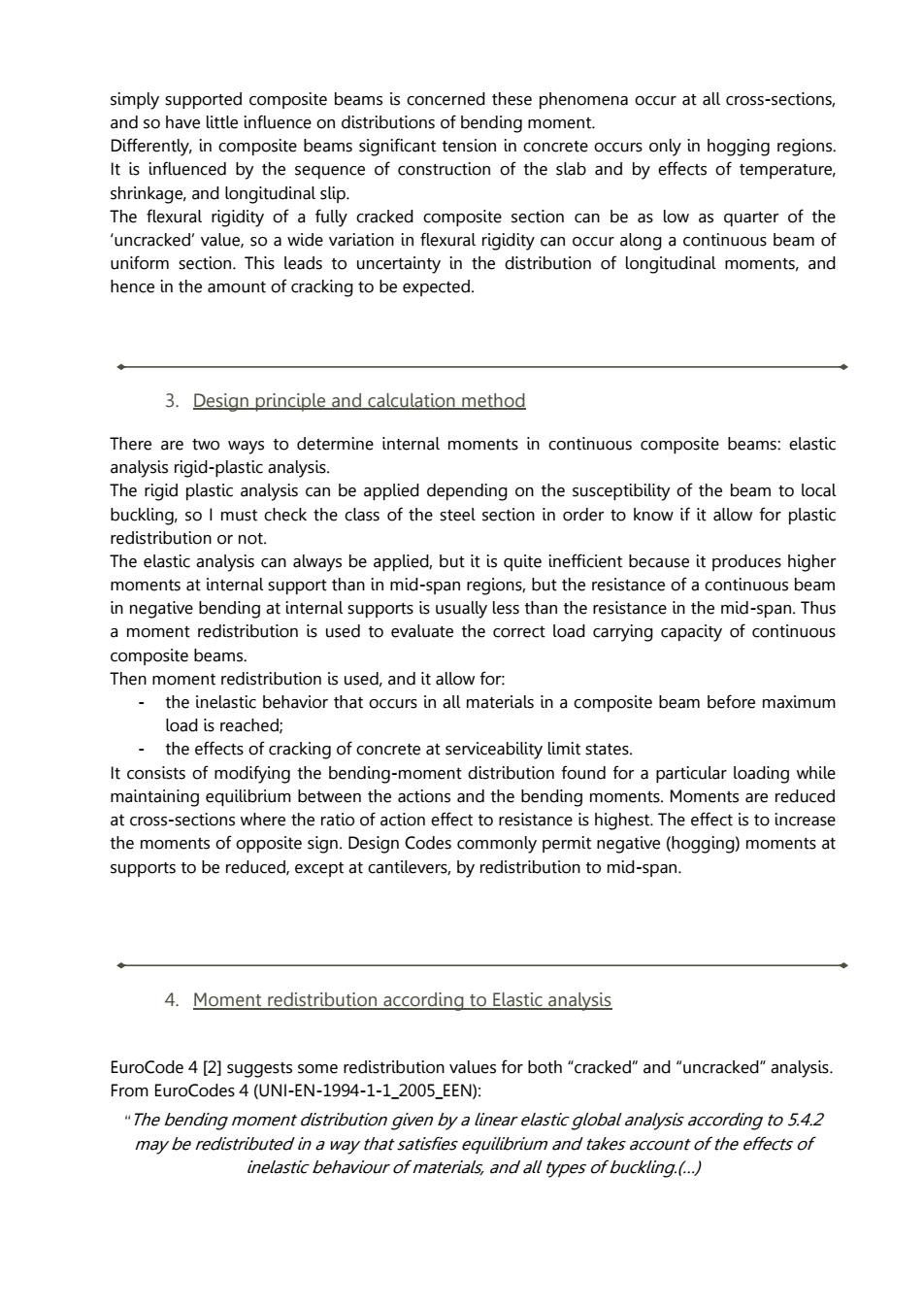正在加载图片...

simply supported composite beams is concerned these phenomena occur at all cross-sections, and so have little influence on distributions of bending moment. Differently,in composite beams significant tension in concrete occurs only in hogging regions. It is influenced by the sequence of construction of the slab and by effects of temperature. shrinkage,and longitudinal slip. The fle al riai of a fully cracked composite section can be as low as quarter of the uncracked value e variation in flex eds to uncertaintyt isibution of longitudinal along a tinuous beam of uniform section.This moments,and hence in the amount of cracking to be expected. 3.Design principle and calculation method There are two ways to determine internal moments in continuous composite beams:elastic analysis rigid-plastic analysis. The rigid plastic analysis can be applied depending on the susceptibility of the beam to local bucklina.so i must check the class of the steel section in order to know if it allow for plastic ution or not can always be applied,but it is quite inefficient because it produces higher moments at inte al suppor than inmid-panbu e resistance of a continuous beam in negative bending at internal supports is usually less than the resistance in the mid d-span.Thus a moment redistribution is used to evaluate the correct load carrying capacity of continuous composite beams. Then moment redistribution is used,and it allow for: the inelastic behavior that occurs in all materials in a composite beam before maximum load is reached: the effects of cracking of concrete at serviceability limit states ifying the bending-moment distribution found for a particular loading while um beween the actionsand the bending moments Monentar at cross-sections where the ratio of action effect to resistance is highest.The effect is to increase the moments of opposite sign.Design Codes commonly permit negative(hogging)moments at supports to be reduced,except at cantilevers,by redistribution to mid-span. 4.Moment redistribution according to Elastic analysis EuroCode 4 [2]suggests some redistribution values for both"cracked"and"uncracked"analysis. From EuroCodes 4(UNI-EN-1994-1-1_2005_EEN): The bending moment distribution given by a linear elastic global analysis according to 5.4.2 may be redistributed in a way that satisfies equilibrium and takes account of the effects of inelastic behaviour of materials,and all types of buckling.(.) simply supported composite beams is concerned these phenomena occur at all cross-sections, and so have little influence on distributions of bending moment. Differently, in composite beams significant tension in concrete occurs only in hogging regions. It is influenced by the sequence of construction of the slab and by effects of temperature, shrinkage, and longitudinal slip. The flexural rigidity of a fully cracked composite section can be as low as quarter of the ‘uncracked’ value, so a wide variation in flexural rigidity can occur along a continuous beam of uniform section. This leads to uncertainty in the distribution of longitudinal moments, and hence in the amount of cracking to be expected. 3. Design principle and calculation method There are two ways to determine internal moments in continuous composite beams: elastic analysis rigid-plastic analysis. The rigid plastic analysis can be applied depending on the susceptibility of the beam to local buckling, so I must check the class of the steel section in order to know if it allow for plastic redistribution or not. The elastic analysis can always be applied, but it is quite inefficient because it produces higher moments at internal support than in mid-span regions, but the resistance of a continuous beam in negative bending at internal supports is usually less than the resistance in the mid-span. Thus a moment redistribution is used to evaluate the correct load carrying capacity of continuous composite beams. Then moment redistribution is used, and it allow for: - the inelastic behavior that occurs in all materials in a composite beam before maximum load is reached; - the effects of cracking of concrete at serviceability limit states. It consists of modifying the bending-moment distribution found for a particular loading while maintaining equilibrium between the actions and the bending moments. Moments are reduced at cross-sections where the ratio of action effect to resistance is highest. The effect is to increase the moments of opposite sign. Design Codes commonly permit negative (hogging) moments at supports to be reduced, except at cantilevers, by redistribution to mid-span. 4. Moment redistribution according to Elastic analysis EuroCode 4 [2] suggests some redistribution values for both “cracked” and “uncracked” analysis. From EuroCodes 4 (UNI-EN-1994-1-1_2005_EEN): “The bending moment distribution given by a linear elastic global analysis according to 5.4.2 may be redistributed in a way that satisfies equilibrium and takes account of the effects of inelastic behaviour of materials, and all types of buckling.(…)